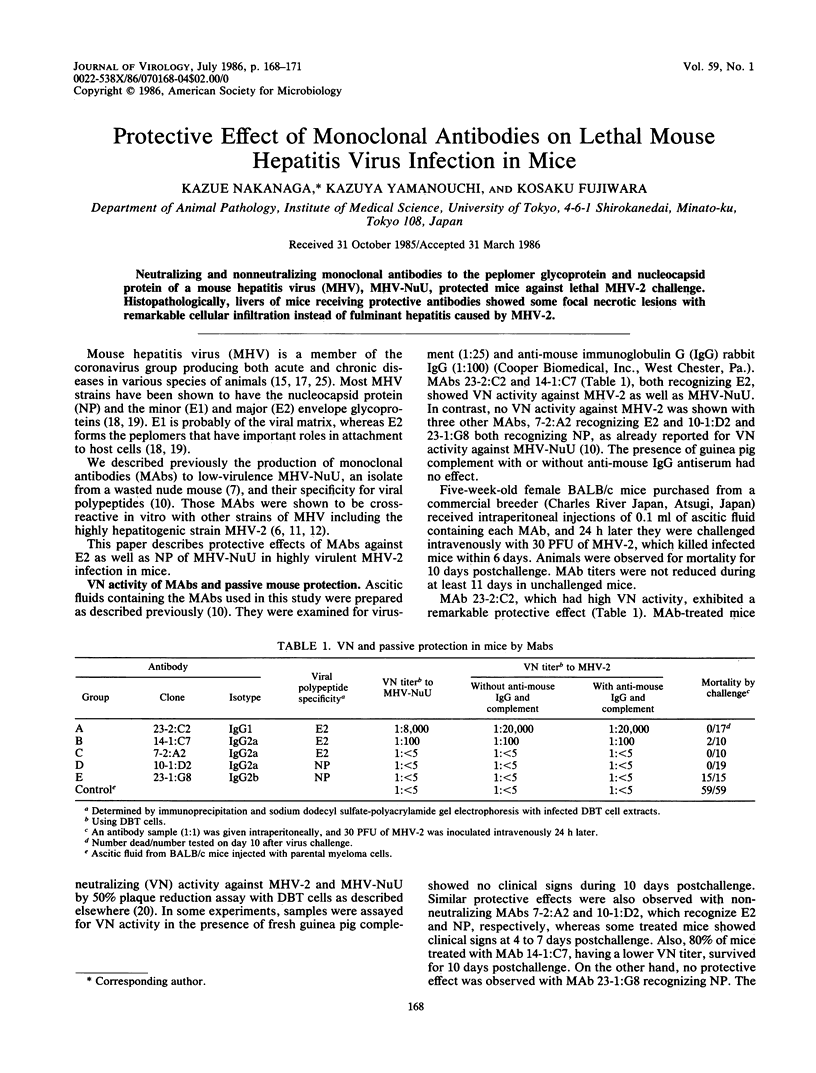Protective effect of monoclonal antibodies on lethal mouse hepatitis virus infection in mice (original) (raw)
Abstract
Neutralizing and nonneutralizing monoclonal antibodies to the peplomer glycoprotein and nucleocapsid protein of a mouse hepatitis virus (MHV), MHV-NuU, protected mice against lethal MHV-2 challenge. Histopathologically, livers of mice receiving protective antibodies showed some focal necrotic lesions with remarkable cellular infiltration instead of fulminant hepatitis caused by MHV-2.

Images in this article
Selected References
These references are in PubMed. This may not be the complete list of references from this article.
- Balachandran N., Bacchetti S., Rawls W. E. Protection against lethal challenge of BALB/c mice by passive transfer of monoclonal antibodies to five glycoproteins of herpes simplex virus type 2. Infect Immun. 1982 Sep;37(3):1132–1137. doi: 10.1128/iai.37.3.1132-1137.1982. [DOI] [PMC free article] [PubMed] [Google Scholar]
- Buchmeier M. J., Lewicki H. A., Talbot P. J., Knobler R. L. Murine hepatitis virus-4 (strain JHM)-induced neurologic disease is modulated in vivo by monoclonal antibody. Virology. 1984 Jan 30;132(2):261–270. doi: 10.1016/0042-6822(84)90033-3. [DOI] [PMC free article] [PubMed] [Google Scholar]
- Hasony H. J., Macnaughton M. R. Antigenicity of mouse hepatitis virus strain 3 subcomponents in C57 strain mice. Arch Virol. 1981;69(1):33–41. doi: 10.1007/BF01315263. [DOI] [PMC free article] [PubMed] [Google Scholar]
- Hirano N., Fujiwara K., Matumoto M. Mouse hepatitis virus (MHV-2). Plaque assay and propagation in mouse cell line DBT cells. Jpn J Microbiol. 1976 Jun;20(3):219–225. [PubMed] [Google Scholar]
- Hirano N., Murakami T., Taguchi F., Fujiwara K., Matumoto M. Comparison of mouse hepatitis virus strains for pathogenicity in weanling mice infected by various routes. Arch Virol. 1981;70(1):69–73. doi: 10.1007/BF01320795. [DOI] [PMC free article] [PubMed] [Google Scholar]
- Hirano N., Tamura T., Taguchi F., Ueda K., Fujiwara K. Isolation of low-virulent mouse hepatitis virus from nude mice with wasting syndrome and hepatitis. Jpn J Exp Med. 1975 Oct;45(5):429–432. [PubMed] [Google Scholar]
- Lefrancois L. Protection against lethal viral infection by neutralizing and nonneutralizing monoclonal antibodies: distinct mechanisms of action in vivo. J Virol. 1984 Jul;51(1):208–214. doi: 10.1128/jvi.51.1.208-214.1984. [DOI] [PMC free article] [PubMed] [Google Scholar]
- Mathews J. H., Roehrig J. T. Determination of the protective epitopes on the glycoproteins of Venezuelan equine encephalomyelitis virus by passive transfer of monoclonal antibodies. J Immunol. 1982 Dec;129(6):2763–2767. [PubMed] [Google Scholar]
- NELSON J. B. Acute hepatitis associated with mouse leukemia. I. Pathological features and transmission of the disease. J Exp Med. 1952 May;95(5):293–302. doi: 10.1084/jem.96.4.293. [DOI] [PMC free article] [PubMed] [Google Scholar]
- Nakanaga K., Kitagawa T., Kiuchi Y., Makino S., Hayami M., Fujiwara K. Production and characterization of monoclonal antibodies to mouse hepatitis virus, MHV-NuU. Nihon Juigaku Zasshi. 1985 Jun;47(3):423–433. doi: 10.1292/jvms1939.47.423. [DOI] [PubMed] [Google Scholar]
- Rector J. T., Lausch R. N., Oakes J. E. Use of monoclonal antibodies for analysis of antibody-dependent immunity to ocular herpes simplex virus type 1 infection. Infect Immun. 1982 Oct;38(1):168–174. doi: 10.1128/iai.38.1.168-174.1982. [DOI] [PMC free article] [PubMed] [Google Scholar]
- Schmaljohn A. L., Johnson E. D., Dalrymple J. M., Cole G. A. Non-neutralizing monoclonal antibodies can prevent lethal alphavirus encephalitis. Nature. 1982 May 6;297(5861):70–72. doi: 10.1038/297070a0. [DOI] [PubMed] [Google Scholar]
- Siddell S. G., Anderson R., Cavanagh D., Fujiwara K., Klenk H. D., Macnaughton M. R., Pensaert M., Stohlman S. A., Sturman L., van der Zeijst B. A. Coronaviridae. Intervirology. 1983;20(4):181–189. doi: 10.1159/000149390. [DOI] [PMC free article] [PubMed] [Google Scholar]
- Siddell S., Wege H., ter Meulen V. The structure and replication of coronaviruses. Curr Top Microbiol Immunol. 1982;99:131–163. doi: 10.1007/978-3-642-68528-6_4. [DOI] [PubMed] [Google Scholar]
- Sturman L. S., Holmes K. V. The molecular biology of coronaviruses. Adv Virus Res. 1983;28:35–112. doi: 10.1016/S0065-3527(08)60721-6. [DOI] [PMC free article] [PubMed] [Google Scholar]
- Taguchi F., Goto Y., Aiuchi M., Hayashi T., Fujiwara K. Pathogenesis of mouse hepatitis virus infection. The role of nasal epithelial cells as a primary target of low-virulence virus, MHV-S. Microbiol Immunol. 1979;23(4):249–262. doi: 10.1111/j.1348-0421.1979.tb00461.x. [DOI] [PMC free article] [PubMed] [Google Scholar]
- Talbot P. J., Salmi A. A., Knobler R. L., Buchmeier M. J. Topographical mapping of epitopes on the glycoproteins of murine hepatitis virus-4 (strain JHM): correlation with biological activities. Virology. 1984 Jan 30;132(2):250–260. doi: 10.1016/0042-6822(84)90032-1. [DOI] [PMC free article] [PubMed] [Google Scholar]
- Townsend A. R., Skehel J. J., Taylor P. M., Palese P. Recognition of influenza A virus nucleoprotein by an H-2-restricted cytotoxic T-cell clone. Virology. 1984 Mar;133(2):456–459. doi: 10.1016/0042-6822(84)90413-6. [DOI] [PubMed] [Google Scholar]
- Virelizier J. L., Allison A. C., Oxford J. S., Schild G. C. Early presence of ribonucleoprotein antigen on surface of influenza virus-infected cells. Nature. 1977 Mar 3;266(5597):52–54. doi: 10.1038/266052a0. [DOI] [PubMed] [Google Scholar]
- Wege H., Dörries R., Wege H. Hybridoma antibodies to the murine coronavirus JHM: characterization of epitopes on the peplomer protein (E2). J Gen Virol. 1984 Nov;65(Pt 11):1931–1942. doi: 10.1099/0022-1317-65-11-1931. [DOI] [PubMed] [Google Scholar]
- Wege H., Siddell S., ter Meulen V. The biology and pathogenesis of coronaviruses. Curr Top Microbiol Immunol. 1982;99:165–200. doi: 10.1007/978-3-642-68528-6_5. [DOI] [PubMed] [Google Scholar]
- Yewdell J. W., Frank E., Gerhard W. Expression of influenza A virus internal antigens on the surface of infected P815 cells. J Immunol. 1981 May;126(5):1814–1819. [PubMed] [Google Scholar]